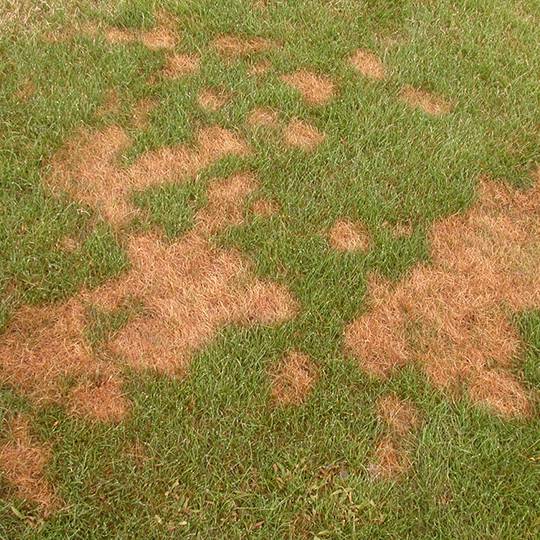
Grasses most commonly affected: perennial ryegrass, creeping bentgrass.
Pythium blight (pythium aphanidermatum, pythium spp.), also referred to as cottony blight and grease spot, occurs in dark patches of grass measuring approximately ½” to 4” in diameter. Greasy-looking and gray in color when wet and yellow in tone after drying, this lawn disease sometimes grows together to form long streaks, usually following a water drainage path on a lawn.
There are more than 20 species of fungus that can result in pythium blight, but pythium aphanidermatum is the most common. Pythium blight’s fungal spores are transported by wind, water, and during lawn mowing. Because of this, the lawn disease often grows in lines following paths where water drainage occurs, or in a lawn’s mowing pattern.
Mycelium, the gray mold created by pythium aphanidermatum, can survive in soil as well as on dead or cut grass blades. It can also generate new spores and infect new plants after only two hours of warm, damp weather conditions.
Pythium Blight Signs and Symptoms
At first, pythium blight looks normal, like dark, damp patches of grass running along damp areas of your grass. Wet, greasy patches can then develop gray mold. Once the infected grass dries, the disease becomes less visible and yellow patches appear where the greasy shapes were.
Pythium aphanidermatum forms gray mycelium or fruiting bodies, giving the “cottony blight” variety of pythium blight its name. Pythium spp. does not form these cottony, gray spores. Pythium aphanidermatum and pythium spp. both damage roots and crowns of grass, which can permanently kill patches of grass if left untreated. The only action to take after this is to plant new grass seeds and wait for them to germinate in the infected area.
Pythium Blight Prevention
Over-fertilization and overwatering are common causes of pythium blight. The disease flourishes in dense, lush grass, and prefers lawns with poor drainage. Fertilize and water sparingly (once a week at long intervals), aerate the soil to prevent thatch buildup, and loosen compacted soil. Fungicides may be required to rid your yard of pythium blight, especially during long summers. Fungicides are most effective against pythium blight during the greasy, dark green stage of an infection.
Because fungicide treatments can be difficult to apply yourself, many choose professional fungicidal prevention applications. Call Cardinal Lawns today to discuss your options for making your lawn look its best.
Need Help with Pythium Blight?
Call Cardinal Lawns today at 614-808-4446 and let's talk about how we can help treat for Pythium Blight and other common Ohio lawn diseases.
Get a Free Quote